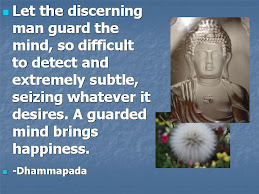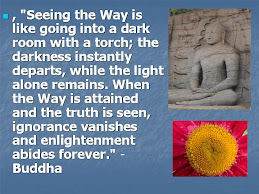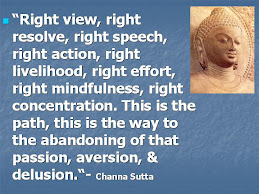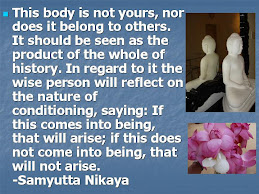(Please click on the figure to enlarge)
Kamma is the result of our will or intention. We discussed before that we have no absolute free will. But we have a will. Therefore we can change our kamma.
Lets take an illustration and see how we make our kamma.
When a person sees an object the person can react or respond in four different ways (See the illustration in the figure above). In this example here it is the identical object comes to their visual field ("A", "B" and "C").
1. The person "A" may react in an unskilful way making "dark kamma" resulting in "dark results."
2. Person "B" may react with "bright kamma" resulting in "bright result."
3. Their could be a person ("A" or "B" or both) with mix of "dark and bright kamma" resulting in mixed results ("dark and bright results").
4. Their is the person "C" is awakened (fully enlightened). This person may respond with kamma that ends kamma (extinguish kamma). This person knows this is a mere flow of Nama Dhamma arising and passing away in the individual's own mind. This is also will be last mental action at death resulting in no future births. All the previous kamma dark or bright does not come to fruit. They end all their kamma with the last kamma that ends kamma.
The above illustration is for eye and object only. The exact same mechanism applies to other senses too, including mind and mind objects. At the time of death mostly mind and mind objects (memories retrieved) as discussed in the mind works model come into play. The awaked has no more taints and therefore flow of thoughts from the mind does not happen. We have discussed this in detail a previous post on taints.
(Please click on the hyperlinked words or phrases to read the previous posts related to this topic if you wish).
Further reading from previous posts.
"... there are four kinds of kamma proclaimed by me after realization myself with direct knowledge.
What are the four?
1.There is dark kamma with dark ripening,
2. There is bright kamma with bright ripening,
3. There is dark-and-bright kamma with dark-and-bright ripening,
4. There is kamma that is not dark and not bright with neither-dark-nor-bright ripening that conduces to the exhaustion of kamma.
Kukkuravatika Sutta: The Dog-duty Ascetic
translated from the Pali by Ñanamoli Thera









































































2 comments:
Great post, thank you.
Yuriy
meditationcorner.com
You are welcome.
Post a Comment